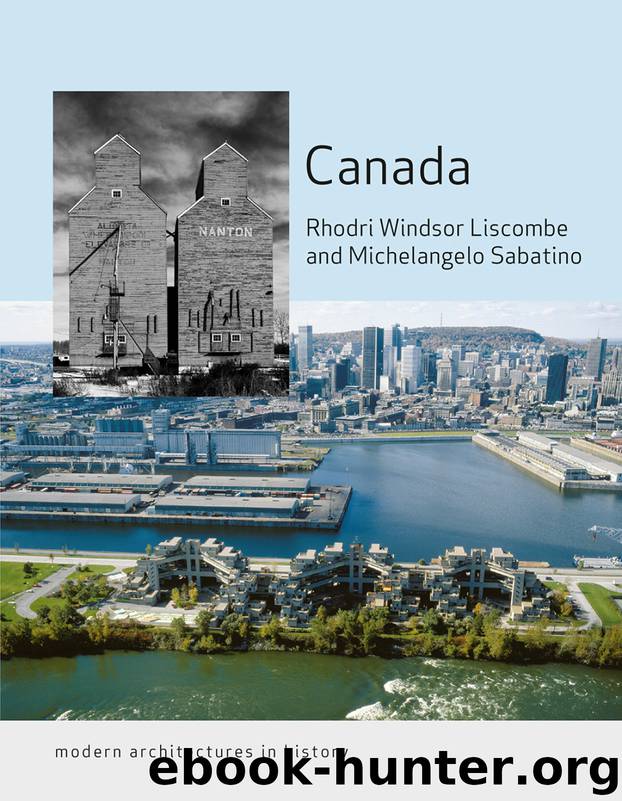Canada by Rhodri Windsor Liscombe & Michelangelo Sabatino

Author:Rhodri Windsor Liscombe & Michelangelo Sabatino
Language: eng
Format: epub
Publisher: REAKTION BOOKS
John C. Parkin, John B. Parkin & Associates office at Don Mills, 1958 (demolished).
STBP, rendering of the executed scheme for the BC Electric Building at Vancouver, 1955–7.
Modernism was on the way to attaining default status in the accommodation of working spaces. As remarked, the most well-known Canadian office towers were designed by the initial generation of ‘starchitects’, notably Pei Cobb Freed & Partners for Place Ville Marie, Montreal, and Mies for the Toronto-Dominion Centre.53 Their architectural prowess was undeniable and benefited in execution by partnering with Canadian firms, respectively ARCOP and John B. Parkin & Associates. But Canadian designers also contributed to commercial modernism. A partial instance is the sheer glass and metal CIL (Canadian Industries Ltd) House on the then eastern fringe of Montreal’s business district. The 33-storey structure, arranged as a conventional stepped tower, was first drawn up by Montreal-based Greenspoon, Freedlander & Dunne, but modified towards their own idiom by Gordon Bunshaft of Skidmore, Owings & Merrill (1960–62).
On the same street Dickinson completed the 45-storey tower for the Canadian Imperial Bank of Commerce in 1962. He perhaps deliberately diverged from the Seagram in inserting strong horizontal features at mid-elevation (triple mechanical floor) and as a cornice. Together with the Welsh green slate spandrels, the horizontal features actually emphasized the near sublime verticality of ‘La Tour CIBC’. As memorable was John C. Parkin’s Bata Shoes Head Office in Don Mills (1965; demolished 2007).54 The shoe company executives were installed in a sumptuously simple three-storey rectangular box in which the shapely reinforced concrete members were pierced by broad fenestration. More remarkably, the whole building was elevated on tree-trunk concrete piers, providing a covered outer precinct and transparent reception lobby. It can be regarded as a more plastic and powerful development of his much-lauded but thinner-limbed Ortho Pharmaceuticals factory and office at Don Mills (1955–6). There the entrance lobby had been expressed as a full-height element, placed asymmetrically and visually linked with the more opaque articulation of the manufacturing space.
Download
This site does not store any files on its server. We only index and link to content provided by other sites. Please contact the content providers to delete copyright contents if any and email us, we'll remove relevant links or contents immediately.
Kathy Andrews Collection by Kathy Andrews(11326)
The remains of the day by Kazuo Ishiguro(8396)
Paper Towns by Green John(4800)
Spare by Prince Harry The Duke of Sussex(4789)
Industrial Automation from Scratch: A hands-on guide to using sensors, actuators, PLCs, HMIs, and SCADA to automate industrial processes by Olushola Akande(4609)
The Body: A Guide for Occupants by Bill Bryson(4586)
Be in a Treehouse by Pete Nelson(3648)
Machine Learning at Scale with H2O by Gregory Keys | David Whiting(3634)
Harry Potter and the Goblet Of Fire by J.K. Rowling(3611)
Never by Ken Follett(3528)
Goodbye Paradise(3446)
The Remains of the Day by Kazuo Ishiguro(3139)
Into Thin Air by Jon Krakauer(3131)
The Cellar by Natasha Preston(3077)
The Genius of Japanese Carpentry by Azby Brown(3040)
Fairy Tale by Stephen King(2950)
120 Days of Sodom by Marquis de Sade(2941)
Drawing Shortcuts: Developing Quick Drawing Skills Using Today's Technology by Leggitt Jim(2941)
The Man Who Died Twice by Richard Osman(2808)
